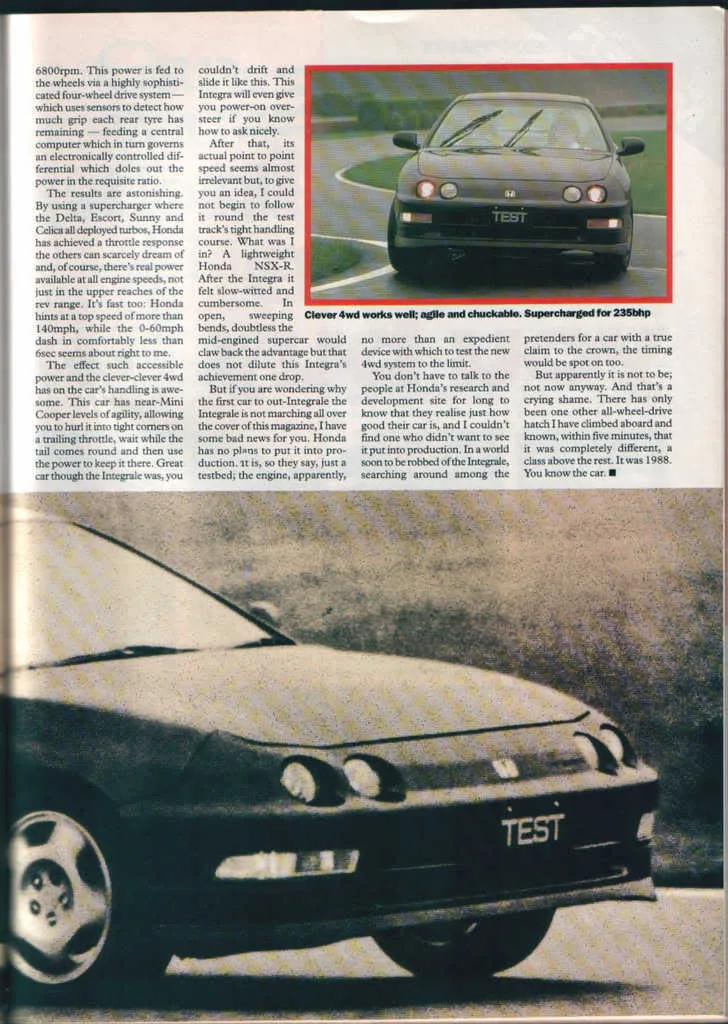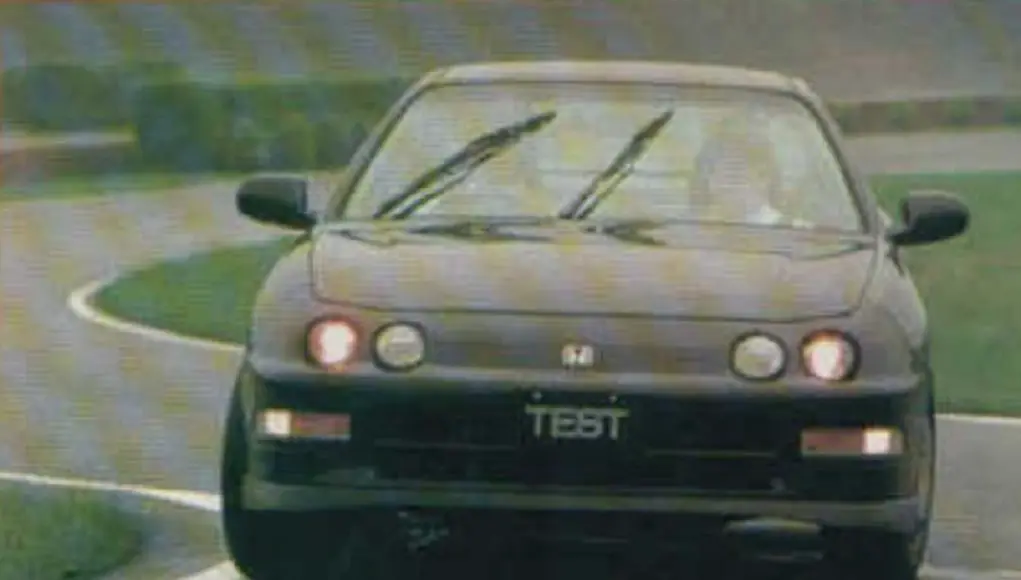Honda commissioned one 1994 Acura Integra GS-R, supercharged it, and added Honda’s Real Time AWD system underneath to make a bona fide Cosworth Beater.
Welcome to JDMObscura where we find cool JDM accessories, trim levels, etc. and talk about them.
Every once in a while when the third generation Acura Integra is brought up someone will invariably butt in and say that the Acura Integra should’ve been All-Wheel drive, which, at that point, I remind them that in some markets the Acura Integra DID come in AWD but only blessed those AWD DB9’s with a D-series single cam. But, did you know that Acura’s engineers made one special Acura Integra GS-R that not only had the aforementioned Real Time AWD unit under its chassis but was supercharged? Yah, I didn’t know about this one-off prototype either, that is until I came across a scanned 1994 issue of AutoCar magazine.
Check out the awesome two-page spread below.
I originally came across this article off of Instagram, but this high-res copy comes courtesy of Fiesta-Si.Com.


What was it?
By 1994 Honda’s Real Time AWD system had been used in a few cars like the third-gen Civic Wagovan, some trim levels of the Civic like the RTSi, and those AWD Integras. Perhaps, in other markets, Honda used its Real Time AWD system, and if they did, please comment those makes and models down below.
1995, however, saw the introduction of the CR-V to the Japanese market which meant throwing some “serious torque” to the Real Time AWD system underneath. While the D16A6 in those AWD Integras only had 130 HP and 105 lb-ft, these new B20 engines where more free-revving with 126 HP and 133 lb-ft. Like I said, monstrous torque.
Honda’s Real Time AWD system uses a multi-plate clutch that connects to a drive shaft of the rear diff. The clutch is turned on and off thanks to an electric motor and hydraulic pump. The overall system doesn’t add as much weight as a traditional full-time 4 wheel drive system but does, under certain conditions, allow some power to be sent to the rear.
Long story short, Honda wanted to test the limits of its Real Time AWD system, rigged it to run all the time in a true four wheel drive configuration and, as the article mentions,
“…power is fed to the wheels via a highly-sophisticated four-wheel drive system – which detects how much grip each rear tire has remaining- feeding a central computer which in turn governs an electronically controlled differential which doles out power in the requisite ratio.”
This is in stark contrast to how Real Time AWD traditionally works which is detecting wheel slip up front before it starts to send power to the rear.
Tail of the tape
Bog-standard GS-R’s where no slouch with their B18C1’s putting out a generous 170 HP and 128 lb-ft, but, all that torque came in at a sky-high 6,200 RPM. 0-60 MPH is around 7.2 seconds
This AWD Acura Integra prototype used a supercharger presumably made in-house for testing purposes which cranked up horsepower to 235 HP and 190 lb-ft (That torque is only an educated guess since the article does not list that figure.) Honda claims this AWD Integra could run to 60 MPH in under six seconds!
How good was it?
According to journalist and test driver Andrew Frankel,
The results are astonishing. By using a supercharger where the Delta, Escort, Sunny, and Celica all deployed turbos, Honda has achieved a throttle response the others can scarcely dream of, and, of course, there’s real power available at all engine speeds, not just in the upper reaches of the rev range. It’s fast too: Honda hints at a top speed of more than 140 MPH.
The car has near-Mini Cooper levels of agility, allowing you to hurl it into tight corners on a trailing throttle, wait while the tail comes round and then use the power to keep it there.
Frankel further goes on to say that the next car he drove on Honda’s proving grounds in Northern Japan, the Acura NSX-R, literally Acura’s fastest car at that time, felt “slow-witted and cumbersome.” Can you imagine telling THAT to Acura’s engineers? Of course, any car enthusiast worth their while knows that adding power throughout the power curve wakes up any chassis.
Why didn’t Acura make this one-off trim level?
For one, this Acura was just a prototype not meant for the rigors of durability testing that, presumably, all its models went through. Sure, the Real Time AWD system could handle all that power, but, for how long?
Then there’s the question of the engine. With the main goal to test the limits of Real Time AWD, adding more power to the B18C1 surely was no problem. But, on stock internals, who knows how long these engines would be in the long run?
There’s also the additional reasearch and development they’d have to go through to come up with a package that would last the life of the car and not just be a flash in the pan. The return on such an investment surely wouldn’t be enough to justify the couple thousands they’d sell worldwide.
And, having a cheaper, more capable and powerful car compared to the NSX would be a non-starter for Acura’s brand image. How bad would it look if their halo car was outshined by an Integra with a Supercharger slapped on?
There are some theorists out there, probably with more knowledge than me about this special car, that contends this AWD prototype was going to be the new Acura Integra Type R and that the track that this test mule bested the NSX on was Honda’s Twin-Ring Motegi. Instead of adding forced induction, they beefed up the B18C1 to be a marvel of naturally aspirated engineering.
Acura’s answer to a barn-burner of an Integra would come four years later with the NA B18C5 in a special chassis they’d dub the Acura Integra Type R. It wouldn’t be as powerful as this one-off but it’d be, as mentioned, naturally aspirated, reliable, and a fuel-sipper underneath VTEC.
There’s also weight. AWD Integras with the D-series comes in at around 2,600 pounds. Add an extra 100 pounds for the B-series VTEC engines and you’re looking at around 2,700-2,800 pounds, no longer that lightweight, a hallmark of Integras.
To me, what this supercharged AWD Integra prototype shows is just how good a regular DC4/DC2 Integra chassis is. Except for a front sway bar and a beefier rear sway bar, the GS-R chassis wasn’t that far removed from the bog standard LS Integra chassis.
While I’d be remiss to not say that Acura missed out on a potential riot of a trim level, they had their reasons and I’ll always associate Integras as being the best FWD chassis out there.
Do you think Acura should’ve made this one-off AWD trim level and developed it further? Do you have anything else to add to this discussion? Let me know your .02 in the comments below!




[…] Earlier last year I blogged about how Acura made a prototype AWD GS-R Integra, to test the capabilit… […]
[…] Acura even had a prototype third gen Integra with a supercharged B-series and four-wheel drive speci… […]